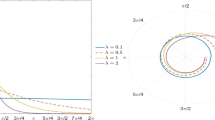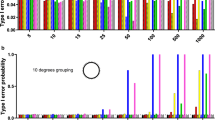Abstract
The analysis of circular data has been recently the focus of a wide range of literature, with the general objective of providing reliable parameter estimates in the presence of heterogeneity and/or dependence among observations under a longitudinal setting. In this paper, we extend the variance component model approach to the analysis of longitudinal circular data, defining a mixed effects model for radial projections onto the circle and introducing dependence between projections through a set of correlated random coefficients. Estimation is carried out by numerical integration through an expectation-maximization algorithm without parametric assumptions upon the random coefficients distribution. The resulting model is a finite mixture of projected normal distributions. A simulation study has been carried out to investigate the behavior of the proposed model in a series of empirical situations. The proposed model is computationally parsimonious and, when applied to a real dataset on animal orientation, produces novel results.





Similar content being viewed by others
References
Aitkin MA (1996) Empirical Bayes shrinkage using posterior random effect means from nonparametric maximum likelihood estimation in general random effect models. In: Statistical Modelling: Proceedings of the 11th IWSM, 87–94
Aitkin MA (1999) A general maximum likelihood analysis of variance components in generalized linear models. Biometrics 55:117–128
Alfó M, Maruotti A, Trovato G (2011) A finite mixture model for multivariate counts under endogenous selectivity. Stat Comput 21:185–202
Artes R, Jorgensen B (2000) Longitudinal data estimating equations for dispersion models. Scand J Stat 27:321–334
Artes R, Paula GA, Ranvaud R (2000) Analysis of circular longitudinal data based on generalized estimating equations. Aust N Z J Stat 42:347–358
Biernacki C, Celeux G, Govaert G (2003) Choosing starting values for the EM algorithm for getting the highest likelihood in multivariate Gaussian mixture models. Comput Stat Data Anal 41:561–575
Böhning D (1995) A review of reliable algorithms for the semi-parametric maximum likelihood estimator of a mixture distribution. J Stat Plan Inference 47:5–28
Bulla J, Lagona F, Maruotti A, Picone M (2012) A multivariate hidden Markov model for the identification of sea regimes from incomplete skewed and circular time series. J Agric Biol Environ Stat 17:544–567
D’Elia A (2001) A statistical model for orientation mechanism. Stat Methods Appl 10:157–174
Di Marzio M, Panzera A, Taylor CC (2012) Smooth estimation of circular cumulative distribution functions and quantiles. J Nonparametr Stat 24:935–949
Di Marzio M, Panzera A, Taylor CC (2014) Nonparametric regression for spherical data. J Am Stat Ass 109:748–763
Downs TD, Mardia KV (2002) Circular regression. Biometrika 89:683–697
Ferreira JT, Steel M (2006) A constructive representation of univariate skewed distributions. J Am Stat Assoc 101:823–829
Fisher NI (1993) Statistical Analysis Circular Data. Cambridge University Press, Cambridge
Fisher NI, Lee AJ (1992) Regression models for angular response. Biometrics 48:665–677
Fitzmaurice G, Davidian M, Verbeke G, Molenberghs G (2008) Longitudinal data analysis. Chapman & Hall, Boca Raton, FL
Heckman J, Singer B (1984) A method for minimizing the impact of distributional assumptions in econometric models of duration. Econometrica 52:271–320
Ingrassia S, Rocci R (2011) Degeneracy of the EM algorithm for the MLE of multivariate Gaussian mixtures and dynamic constraints. Comput Stat Data Anal 55:1715–1725
Jammalamadaka RA, SenGupta A (2001) Topics in circular statistics. World Scientific, Singapore
Johnson RA, Wehrly TE (1978) Some angular-linear distributions and related regression models. J Am Statl Assoc 73:602–606
Jona-Lasinio G, Gelfand A, Jona-Lasinio M (2012) Spatial analysis of wave direction data using wrapped Gaussian processes. Ann Appl Stat 6:1478–1498
Laird NM (1978) Nonparametric maximum likelihood estimation of a mixing distribution. J Am Statl Assoc 73:805–811
Lagona F (2015) Regression analysis of correlated circular data based on the multivariate von Mises distribution. Environ Ecol Stat, to appear
Lagona F, Picone M (2013) Maximum likelihood estimation of bivariate circular hidden Markov models from incomplete data. J Stat Comput Simul 83:1223–1237
Lagona F, Picone M (2012) Model-based clustering of multivariate skew data with circular components and missing values. J Appl Stat 39:927–945
Lee A (2010) Circular data. Wiley Interdiscip Rev 2:477–486
Mardia KV, Jupp PE (2000) Directional statistics. Wiley, USA
Martinez-Zarzoso I, Maruotti A (2013) The environmental Kuznets curve: functional form, time-varying heterogeneity and outliers in a panel setting. Environmetrics 24:461–475
Martinez-Zarzoso I, Maruotti A (2011) The impact of urbanization on CO2 emissions: evidence from developing countries. Ecol Econ 70:1344–1353
Mastrantonio G, Jona-Lasinio G, Maruotti A (2015) Bayesian hidden Markov modelling using circular-linear general projected normal distribution. Environmetrics 26:145–158
McLachlan G, Peel D (1999) The EMMIX algorithm for the fitting of Normal and t-components. J Stat Softw 4:2
Nunez-Antonio G, Gutierrez-Pena E (2014) A Bayesian model for longitudinal circular data based on the projected normal distribution. Comput Stat Data Anal 71:506–519
Presnell B, Morrison SP, Littell RC (1998) Projected multivariate linear model for directional data. J Am Statl Assoc 93:1068–1077
R Core Team (2014) R: A language and environment for statistical computing. R Foundation for Statistical Computing. Vienna, Austria. URL http://www.R-project.org
Rivest LP (1997) A decentred predictor for circular-circular regression. Biometrika 84:717–726
Sarma Y, Jammalamadaka S (1993) Circular regression. Statistical science and data analysis. In: Proceeding of the thrid Pacific area statistical conference: 109–128. VSP: Utrecht, Netherlands
Song PXK (2007) Correlated data analysis. Springer, Berlin
Teicher H (1967) Identifiability of mixtures of product measures. Ann Math Stat 38:1300–1302
Verbeke G, Fieuws S, Molenberhs G, Davidian M (2014) The analysis of multivariate longitudinal data: a review. Stat Methods Med Res 23:42–59
Wang F (2013) Space and space-time modeling of directional data. Ph.D Thesis, Department of Statistical Science in the Graduate School of Duke University
Wang F, Gelfand A (2013) Directional data analysis under the general projected normal distribution. Stat Methodol 10:113–127
Wang F, Gelfand A (2014) Modeling space and space-time directional data using projected Gaussian processes. J Am Stat Assoc 109:1565–1580
Wang F, Gelfand A, Jona-Lasinio G (2015) Joint spatio-temporal analysis of a linear and a directional variable: space-time modeling of wave heights and wave directions in the Adriatic Sea. Stat Sinica 25:25–39
Yakowitz S, Spragins J (1968) On the identifiability of finite mixtures. Ann Math Stat 39:209–214
Acknowledgments
The author thanks the referees for the precise review of my article and the very useful comments. They have been precious in order to improve the quality of the paper. The author is grateful to Gianluca Mastrantonio for his comments on a draft version of this paper.
Author information
Authors and Affiliations
Corresponding author
Ethics declarations
Conflict of interest
The author declares that he has no conflict of interest.
Additional information
Handling Editor: Pierre Dutilleul.
Rights and permissions
About this article
Cite this article
Maruotti, A. Analyzing longitudinal circular data by projected normal models: a semi-parametric approach based on finite mixture models. Environ Ecol Stat 23, 257–277 (2016). https://doi.org/10.1007/s10651-015-0338-3
Received:
Revised:
Published:
Issue Date:
DOI: https://doi.org/10.1007/s10651-015-0338-3




